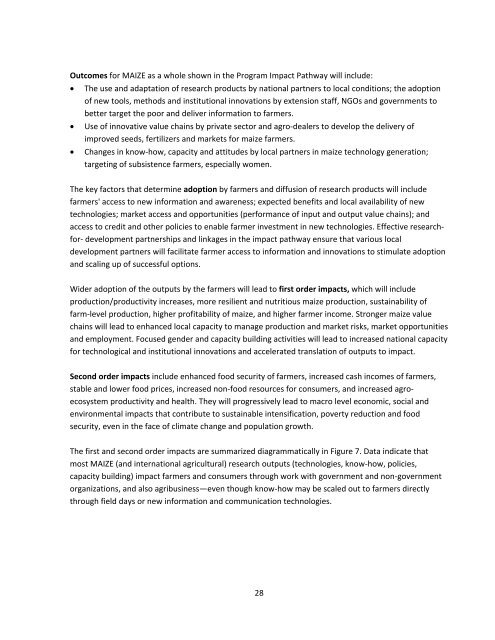Download - Maize
Download - Maize
Download - Maize
You also want an ePaper? Increase the reach of your titles
YUMPU automatically turns print PDFs into web optimized ePapers that Google loves.
Outcomes for MAIZE as a whole shown in the Program Impact Pathway will include:<br />
The use and adaptation of research products by national partners to local conditions; the adoption<br />
of new tools, methods and institutional innovations by extension staff, NGOs and governments to<br />
better target the poor and deliver information to farmers.<br />
Use of innovative value chains by private sector and agro‐dealers to develop the delivery of<br />
improved seeds, fertilizers and markets for maize farmers.<br />
Changes in know‐how, capacity and attitudes by local partners in maize technology generation;<br />
targeting of subsistence farmers, especially women.<br />
The key factors that determine adoption by farmers and diffusion of research products will include<br />
farmers' access to new information and awareness; expected benefits and local availability of new<br />
technologies; market access and opportunities (performance of input and output value chains); and<br />
access to credit and other policies to enable farmer investment in new technologies. Effective researchfor‐<br />
development partnerships and linkages in the impact pathway ensure that various local<br />
development partners will facilitate farmer access to information and innovations to stimulate adoption<br />
and scaling up of successful options.<br />
Wider adoption of the outputs by the farmers will lead to first order impacts, which will include<br />
production/productivity increases, more resilient and nutritious maize production, sustainability of<br />
farm‐level production, higher profitability of maize, and higher farmer income. Stronger maize value<br />
chains will lead to enhanced local capacity to manage production and market risks, market opportunities<br />
and employment. Focused gender and capacity building activities will lead to increased national capacity<br />
for technological and institutional innovations and accelerated translation of outputs to impact.<br />
Second order impacts include enhanced food security of farmers, increased cash incomes of farmers,<br />
stable and lower food prices, increased non‐food resources for consumers, and increased agroecosystem<br />
productivity and health. They will progressively lead to macro level economic, social and<br />
environmental impacts that contribute to sustainable intensification, poverty reduction and food<br />
security, even in the face of climate change and population growth.<br />
The first and second order impacts are summarized diagrammatically in Figure 7. Data indicate that<br />
most MAIZE (and international agricultural) research outputs (technologies, know‐how, policies,<br />
capacity building) impact farmers and consumers through work with government and non‐government<br />
organizations, and also agribusiness—even though know‐how may be scaled out to farmers directly<br />
through field days or new information and communication technologies.<br />
28

















